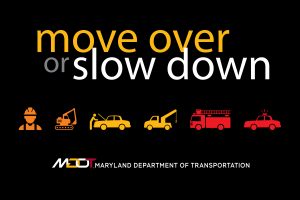
GLEN BURNIE, MD (September 29, 2022) – The Maryland Department of Transportation Motor Vehicle Administration (MDOT MVA) is alerting customers of several new bills taking effect October 1, including two – Senate Bill 176 and Senate Bill 218 – that were introduced by MDOT MVA leadership, passed by the General Assembly and signed into law earlier this year by Governor Larry Hogan.
The first measure is designed to help protect infants and toddlers in the event of a crash while also providing caregivers with clear guidance on child passenger safety. Senate Bill 176 requires a child under age 2 being transported in a motor vehicle to be secured in a rear-facing child safety seat that complies with federal regulations until the child reaches the manufacturer’s weight or height limit for the child safety seat. More information and resources can be found through MDOT MVA’s Highway Safety Office here.
The second measure, Senate Bill 218, allows MDOT MVA to issue a temporary renewal for qualified individuals for up to two years for driver’s licenses and identification (ID) cards. The bill was introduced by MDOT MVA as a result of lessons learned during COVID-19.
Prior to enactment of Senate Bill 218, MDOT MVA could only extend driver’s licenses and ID cards for 90 days, which was not sufficient under certain circumstances, for instance active-duty military members, students studying outside the state, and those who are at risk during state of emergency. Increasing the temporary renewal period gives customers more flexibility when they are unable to visit a branch office.
“MDOT MVA is not only committed to improving our customer’s experience when conducting agency business, but also to providing education to prevent motor vehicle injuries and fatalities,” said MDOT MVA Administrator Chrissy Nizer, who also serves as Governor Larry Hogan’s Highway Safety Representative. “Our team did a tremendous job turning challenges presented during the pandemic into opportunities for the agency to implement customer-oriented changes and ensuring our most vulnerable road users are receiving the utmost protection while traveling.”
Another key measure taking effect October 1 is Senate Bill 147, which expands Maryland’s Move Over Law. The revision requires drivers to move over or slow down when approaching any vehicle that is stopped or parked and displaying hazard warning lights, road flares or other caution signals. Previously, the “move over or slow down” provision applied only when approaching law enforcement vehicles, tow trucks and emergency response vehicles and equipment.
Another new law is the result of House Bill 222, and requires the driver of a vehicle traveling slower than the general speed of traffic on an interstate highway in a rural area to drive the vehicle in the right-hand lanes. The law also mandates that MDOT MVA include information about this requirement in the state’s driver education curriculum.
Several other bills taking effect October 1 have an impact on MDOT MVA’s processes. House Bill 1076 allows MDOT MVA to issue an electronic 24-hour registration to the new owner of a vehicle to allow transport of the vehicle home after purchase. House Bill 368 requires MDOT MVA to allow a 10-day grace period for a customer to return or provide paperwork for registration tags to be returned before issuing a penalty for lapse of insurance following cancellation of a vehicle’s policy.
Other bills going into effect on October 1 related to motor vehicle operations include:
- HB 0157: Vehicle Laws – Plug-In Electric Drive Vehicles – Reserved Parking Spaces prohibits anyone from stopping, standing or parking a vehicle in a parking space designated for plug-in electric drive vehicles.
- HB 0679: Vehicle Laws – Licensing of Businesses and Occupations – Definition of Vehicle Salesman requires anybody who negotiates with a person to enter into a financial security or warranty agreement on behalf of a dealer to obtain a salesman license.
- HB 1150: Vehicle Equipment – Highway Maintenance and Service – Green Flashing Lights allows certain highway maintenance and service equipment and vehicles, while in use for snow removal or the protection of highway maintenance workers, to be equipped display green flashing lights simultaneously with yellow or amber flashing lights. The change eliminates a restriction of these types of lights that previously existed.
###